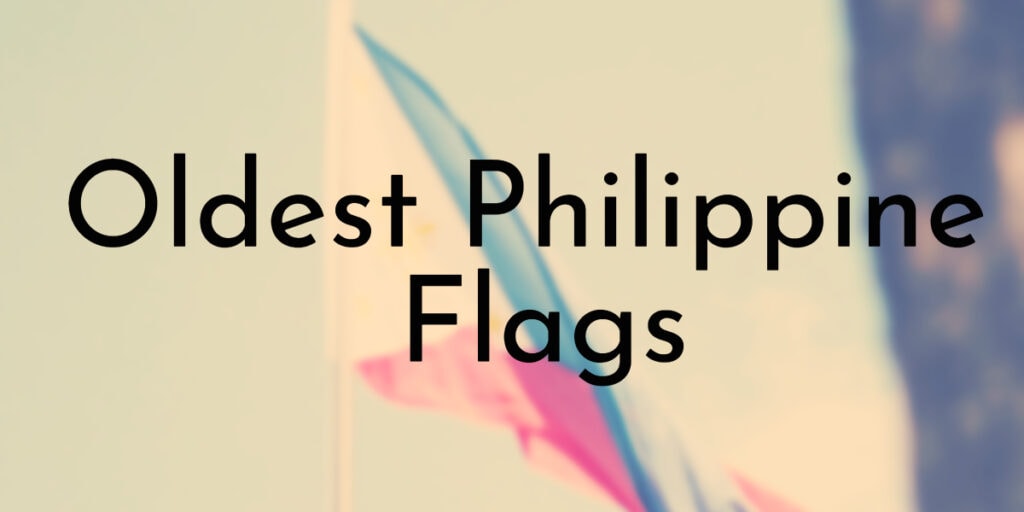The Philippine flag is a symbol of the country’s national identity and struggle for independence. Throughout the nation’s history, several flags have represented the Philippines and its people.
These flags used throughout Philippine history play a significant role in the country’s struggle for independence and national identity. They are symbols of the people’s struggles, sacrifices, and aspirations for freedom and self-determination. These flags represent the Filipino people’s pride, courage, and determination to fight for their rights and liberties.
In this blog post, we will explore the oldest Philippine flags ever used to represent the country, their histories, and what they symbolize. We will take a closer look at the various flags that have been used throughout Philippine history. Join us on this journey as we discover the rich and vibrant history of the Philippines through its flags.
6. The Philippine National Flag
Date Created: May 28, 1898
Color/s: Blue, Crimson Red, White, Gold
Size: 45 x 90 units
Designed by: Emilio Aguinaldo
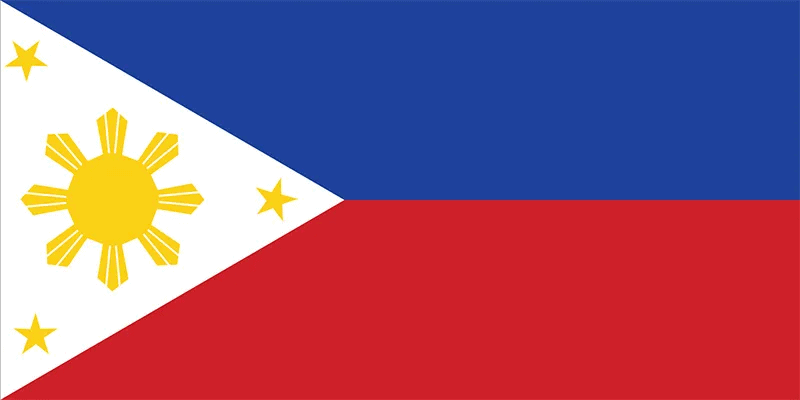
The Philippine National Flag is a symbol of the country’s sovereignty, unity, and freedom. Its design represents the country’s unique history and cultural heritage. The flag features a blue and red field, representing peace, truth, and justice, and a white triangle with a sun and three stars in the center.
The flag’s design has gone through several changes since the Philippines declared independence from Spain on June 12, 1898. The creation of the Philippine National Flag was a collaborative effort between several Filipino patriots, including Emilio Aguinaldo, the first President of the Philippines, and Marcela Agoncillo, Lorenza Agoncillo, and Delfina Herbosa de Natividad, who is credited with sewing the flag. In 1897, during the Philippine Revolution against Spanish colonial rule, Aguinaldo asked the three to create a national flag for the country.
The women were living in Hong Kong at the time, and they used their skills in embroidery and sewing to create the flag. After the flag was completed, it was presented to Aguinaldo in Hong Kong and was later brought to the Philippines.
Did You Know?
The flag’s design was inspired by the flag of the Cuban revolutionaries, who were also fighting for independence from Spain.
5. Gregorio del Pilar Flag
Date Created: 1897
Color/s: Black, Red, Blue
Size: 90 cm. x 150 cm.
Designed by: Gregorio del Pilar

The flag of Gregorio del Pilar is considered one of the most significant symbols of the Philippine Revolution. The upper stripe of the flag was colored red, which represented the color of the Katipunan, while the lower stripe was black, which was taken from General Llanera’s flag.
The flag was hoisted during the Battle of Tirad Pass, where the young general and his troops valiantly defended their position against the invading American forces. Although the battle ended in defeat, the bravery and patriotism displayed by General Gregorio del Pilar and his troops have become an integral part of Philippine history and culture.
Did You Know?
The Gregorio del Pilar Flag was the first Filipino tricolor flag, and its use during the revolution showed the unity and strength of the Filipino people.
4. Sun of Liberty
Date Created: March 17, 1897
Color/s: Red, White
Size: Unspecified
Designed by: Emilio Aguinaldo
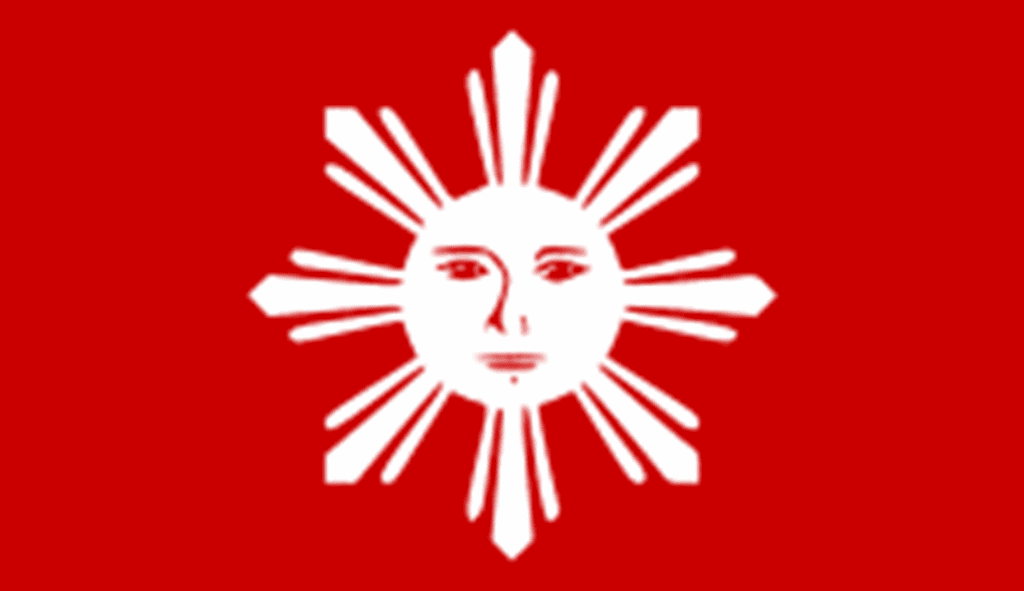
The Sun of Liberty flag has a crucial role in Philippine history as it served as the initial official flag of General Emilio Aguinaldo’s revolutionary government. It was first flown on March 17, 1897, and was the national flag for less than a year until the Pact of Biak-na-Bato was signed in December 1897.
The flag was created by revolutionary leaders during their assembly in Naic, Cavite, and was a modified version of the Aguinaldo-Magdalo flag. Despite being used for only a short period, the flag played a significant role in the struggle for independence in the Philippines.
Its use during some of the darkest days of the revolution, including the Battle of Alapan and the Battle of Imus, demonstrated the courage and determination of the Filipinos to fight for their freedom. The Sun of Liberty flag represents the hope and aspirations of the Filipino people toward their sovereignty, and it continues to inspire generations of Filipinos to this day.
Did You Know?
The Sun of Liberty flag had a red background with a white sun of eight rays at the center symbolizing the search for liberty.
3. Bungo ni Llanera
Date Created: 1896
Color/s: Black, White
Size: approximately 3 ft. x 5 ft.
Designed by: Mariano Llanera
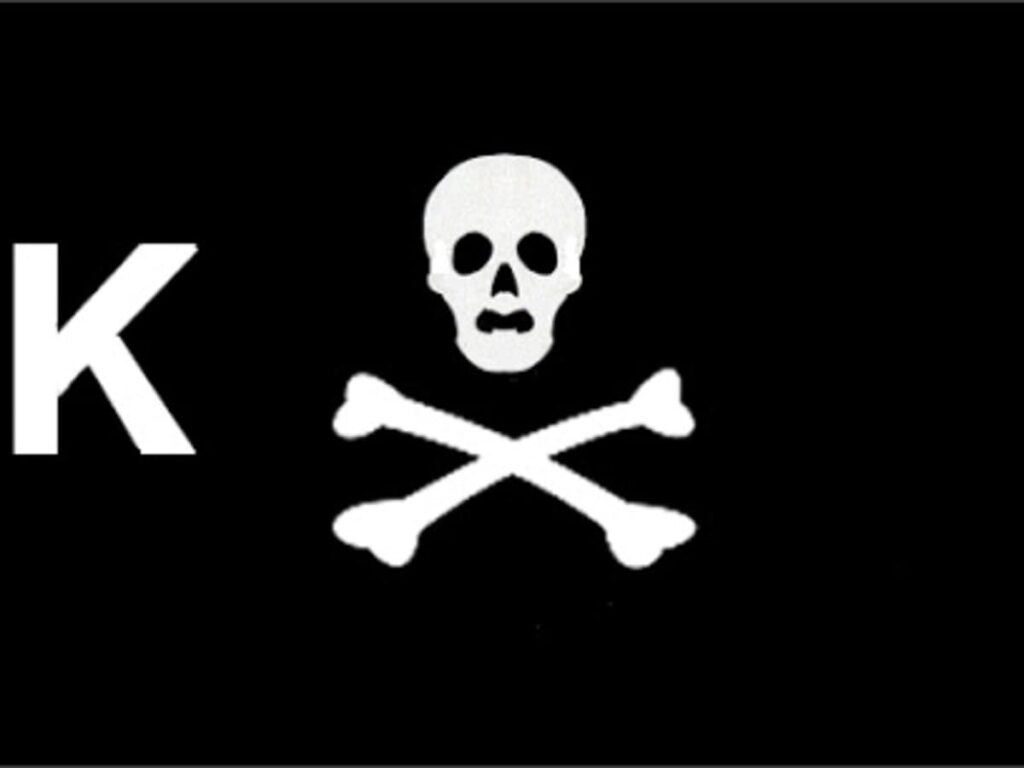
Bungo ni Llanera’s flag is a fascinating piece of history that holds both symbolic and historical significance. Llanera’s flag was carried during the 1896 revolution, and it featured a skull and crossbones with the initials of the Katipunan placed below it. The flag was designed to invoke fear in the enemy and to signify death to the enemies. The skull and crossbones have long been associated with piracy, and it is no wonder that pirate fans find Llanera’s flag particularly interesting.
However, the use of this symbol by Llanera was more aligned with the masonic and Katipunan symbolisms than with piracy. The skull represented the triumph over death and the willingness to sacrifice one’s life for a greater cause, while the crossbones symbolized the bones of the fallen.
Did You Know?
Interestingly, Llanera’s flag was not well received by Andres Bonifacio, the founder of the Katipunan. Bonifacio even gave the flag a mocking nickname, “Bungo ni Llanera” or “Llanera’s skull.” Despite this, Llanera’s flag continued to be used by him and his men during battles, including the Cry of Nueva Ecija.
2. Ang Bandila ng Matagumpay
Date Created: July 11, 1895
Color/s: Red, White
Size: approximately 3 ft. x 5 ft.
Designed by: Unspecified
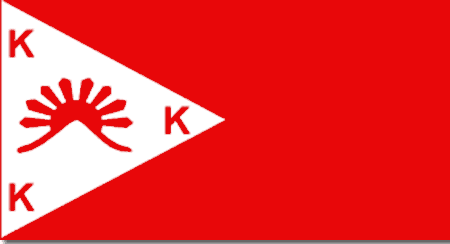
Ang Bandila ng Matagumpay, also known as the Flag of the Victorious, is a significant symbol of the Philippine Revolution. General Pio del Pilar made the flag famous when he used it during the Philippine Revolution. The red flag with a white triangle on the left side, known as the Pio del Pilar’s Rising Sun Flag, was used by him until the signing of the Pact of Biak-na-Bato.
Pio del Pilar was one of Emilio Aguinaldo’s most trusted generals. The flag was first used on July 11, 1895. The designer of the Bandila ng Matagumpay is not known. It is believed to have been created by one of the revolutionaries during the early stages of the Philippine Revolution, possibly by General Pio del Pilar himself or one of his associates.
The Bandila ng Matagumpay was a flag that featured a red background with a white triangle located on the left side. This triangular strip served as the inspiration for the design of the national flag. The triangle had a letter K placed at each of its angles, while the middle of the flag contained a rising sun with eight rays.
Did You Know?
The Bandila ng Matagumpay was the first flag to illustrate an eight-rayed sun, which later became a common element in many Philippine flags. It also served as an inspiration for other revolutionary flags that emerged during the Philippine Revolution.
1. Katipunan Flag
Date Created: August 23, 1896
Color/s: Red, White
Size: approximately 3 ft. x 5 ft. (standard flag size during the revolution)
Designed by: Gregoria De Jesus

The Katipunan Flag is considered the oldest Philippine flag ever. It was created in 1892 by Gregoria de Jesus, the wife of Andres Bonifacio, the founder of the revolutionary society known as the Kataastaasan at Kagalanggalang Katipunan ng Mga Anak ng Bayan (KKK). The flag was uncomplicated but carried significant meaning. It consisted of a rectangular red cloth with the acronym KKK in white letters arranged horizontally at the center.
The red color of the flag symbolized the blood and courage of the Katipuneros who were willing to fight for their freedom and independence from Spanish colonial rule. It was a powerful reminder of the sacrifices made by the members of the Katipunan who were prepared to shed their blood for the cause.
This flag was used during the “First Cry of Nationhood” in August 1896, when the Katipunan launched a rebellion against the Spanish colonial government in Manila. It was a historic event that marked the start of the Revolution and the struggle for independence.
Did You Know?
The Katipunan Flag served as a symbol of unity and resistance against oppression, inspiring the Filipino people to fight for their rights and sovereignty. It was a powerful and meaningful representation of the revolutionary spirit of the Philippine people and their quest for freedom.


